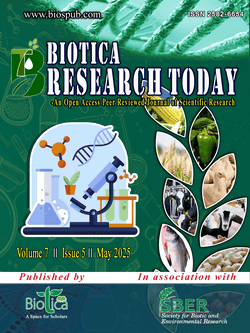
Impact of Sustainable Feed from Vegetable Waste on Coloration in Black Molly (Poecilia sphenops)
Vikranti Patel*
Dept. of Zoology, Government College, Daman, Dadra and Nagar Haveli and Daman and Diu (396 210), India
Kapila Manoj
Dept. of Aquatic Biology, Veer Narmad South Gujarat University, Surat, Gujarat (395 007), India
DOI: https://doi.org/10.54083/BRT/7.5.2025/158-164
Keywords: Black molly, Environmental pollution, Fish feed, Vegetable waste
Abstract
A large amount of vegetable and fruit waste is dumped into landfills and rivers every year, posing an environmental hazard. Many of these wastes, including outer leaves, stems, peels and leftover parts are high in nutrients and can be used in the preparation of feed for livestock. To observe the effect of vegetable waste on the pigment concentration of fish, a three-month experiment was conducted. Black mollies (Poecilia sphenops), which are known for their dark skin pigmentation were taken as an experimental species. A total of 18 Black Molly fingerlings (6 per group) were used in the experiment. Survival rate, SGR and FCR was estimated to assess the performance. Pigment concentration data were examined using one-way ANOVA (p<0.05) with SPSS (Version 26). An experimental feed (F3) was prepared by combining three types of vegetable wastes: sponge gourd peel, cauliflower stem and cabbage outer leaves. The effect of this feed was compared to control feed (F2) and commercial feed (F1). The pigment concentration in an experimental fish was measured at 450, 475 and 500 nm before starting the experiment and following its completion. Fish fed with the experimental feed (F3) showed a significantly higher concentration of pigments (0.032 µg g-1, p<0.001) compared to fish fed on F1 and F2. This study concludes that incorporating vegetable waste into fish feed improves pigmentation in fish and offers an environmentally friendly solution to such kind of waste disposal.
Downloads
not found
Reference
Clarke, A., 1991. What is cold adaptation and how should we measure it? American Zoologist 31(1), 81-92. DOI: https://doi.org/10.1093/icb/31.1.81.
Clarke, A., Johnston, N.M., 1999. Scaling of metabolic rate with body mass and temperature in teleost fish. Journal of Animal Ecology 68(5), 893-905. DOI: https://doi.org/10.1046/j.1365-2656.1999.00337.x.
Debbarma, S., Devi, N.C., Yirang, Y., Yadav, N.K., Lal, J., 2023. Emerging importance of sustainable feed ingredients as a substitution of traditional fish meal in fish feed production: An essential step for sustainable aquaculture. Research Biotica 5(1), 11-15. DOI: https://doi.org/10.54083/resbio/5.1.2023/11-15.
FAO, 1997. Aquaculture Development. FAO Technical Guidelines for Responsible Fisheries No. 5. FAO, Rome, Italy. p. 40.
Galkanda-Arachchige, H.S.C., Hussain, A.S., Davis, D.A., Improvement in laboratory research: Effects of stocking density, variation and sample size on outcomes of growth studies with shrimp. Aquaculture Research 53, 1-13. DOI: https://doi.org/10.1111/are.15620.
Grether, G.F., Hudon, J., Millie, D.F., 1999. Carotenoid limitation of sexual coloration along an environmental gradient in guppies. Proceedings of the Royal Society B (Biological Sciences) 266(1426), 1317-1322. DOI: https://doi.org/10.1098/rspb.1999.0781.
Harpaz, S., Padowicz, D., 2007. Colour enhancement in the ornamental dwarf cichlid Microgeophagus ramirezi by addition of plant carotenoids to the fish diet. The Israeli Journal of Aquaculture-Bamidgeh 59(4), 195-200. DOI: https://doi.org/10.46989/001c.20536.
Hasan, M.R., 2007. Economics of Aquaculture Feeding Practices in Selected Asian Countries. FAO Fisheries Technical Paper No. 505. FAO, Rome, Italy. p. 205.
Ilakiya, T., Parameswari, E., Davamani, V., Yazhini, G., 2020. Organic vegetable production. Research Biotica 2(2), 50-54. DOI: https://doi.org/10.54083/resbio.2.2.2020.50-54.
Kumar, P., Jain, K.K., MunilKumar, S., Sudhagar, S.A., 2017. Alternate feeding strategies for optimum nutrient utilization and reducing feed cost for semi-intensive practices in aquaculture system - A review. Agricultural Reviews 38(2), 145-151. DOI: https://doi.org/10.18805/ag.v38i02.7946.
Li, X., Wang, F., Ta, N., Huang, J., 2025. The compositions, characteristics, health benefits and applications of anthocyanins in Brassica crops. Frontiers in Plant Science 16, 1544099. DOI: https://doi.org/10.3389/fpls.2025.1544099.
Mo, W.Y., Choi, W.M., Man, K.Y., Wong, M.H., 2020. Food waste-based pellets for feeding grass carp (Ctenopharyngodon idellus): Adding baker’s yeast and enzymes to enhance growth and immunity. Science of the Total Environment 707, 134954. DOI: https://doi.org/10.1016/j.scitotenv.2019.134954.
Nassar, A.A.M.A., Gharib, A.A.E., Abdelgalil, S.Y., AbdAllah, H.M., Elmowalid, G.A., 2024. Immunomodulatory, antioxidant, and growth-promoting activities of dietary fermented Moringa oleifera in Nile tilapia (Oreochromus niloticus) with in-vivo protection against Aeromonas hydrophila. BMC Veterinary Research 20, 231. DOI: https://doi.org/10.1186/s12917-024-04070-3.
Nhan, H.T., Minh, T.X., Liew, H.J., Hien, T.T.T., Jha, R., 2019. Effects of natural dietary carotenoids on skin coloration of false Clownfish (Amphiprion ocellaris Cuvier, 1830). Aquaculture Nutrition 25(4), 979-988. DOI: https://doi.org/10.1111/anu.12887.
Pauly, D., 1980. On the interrelationships between natural mortality, growth parameters, and mean environmental temperature in 175 fish stocks. ICES Journal of Marine Science 39(2), 175-192. DOI: https://doi.org/10.1093/icesjms/39.2.175.
Price, A.C., Weadick, C.J., Shim, J., Rodd, F.H., 2008. Pigments, patterns, and fish behavior. Zebrafish 5(4), 297-307. DOI: https://doi.org/10.1089/zeb.2008.0551.
Ramzan, K., Zehra, S.H., Balciunaitiene, A., Viskelis, P., Viskelis, J., 2025. Valorization of fruit and vegetable waste: An approach to focusing on extraction of natural pigments. Foods 14(8), 1402. DOI: https://doi.org/10.3390/foods14081402.
Rana, S., Bari, A.A., Shimul, S.A., Mazed, M.A., Nahid, S.A.A., 2023. Enhancement of body coloration of sword-tail fish (Xiphophorus helleri): Plant-derived bio-resources could be converted into a potential dietary carotenoid supplement. Heliyon 9(4), e15208. DOI: https://doi.org/10.1016/j.heliyon.2023.e15208.
Reboul, E., 2013. Absorption of vitamin A and carotenoids by the enterocyte: Focus on transport proteins. Nutrients 5(9), 3563-3581. DOI: https://doi.org/10.3390/nu5093563.
Sathyaruban, S., Uluwaduge, D.I., Yohi, S., Kuganathan, S., 2021. Potential natural carotenoid sources for the colouration of ornamental fish: A review. Aquaculture International 29(4), 1507-1528. DOI: https://doi.org/10.1007/s10499-021-00689-3.
Searcy-Bernal, R., 1994. Statistical power and aquacultural research. Aquaculture 127(4), 371-388. DOI: https://doi.org/10.1016/0044-8486(94)90239-9.
Tedesco, D.E.A., Scarioni, S., Tava, A., Panseri, S., Zuorro, A., 2021. Fruit and vegetable wholesale market waste: Safety and nutritional characterisation for their potential re-use in livestock nutrition. Sustainability 13(16), 9478. DOI: https://doi.org/10.3390/su13169478.
